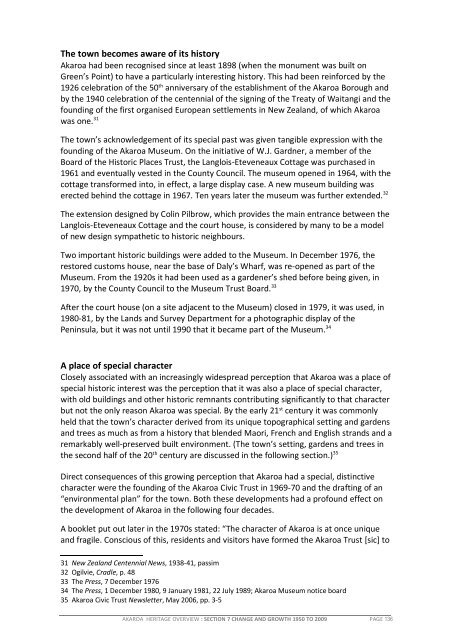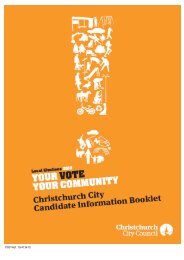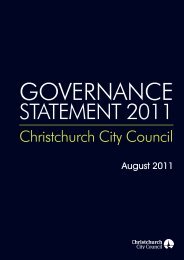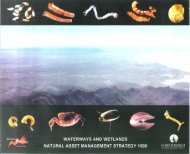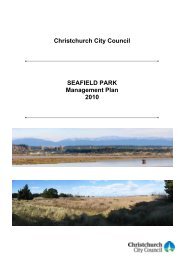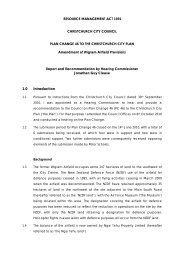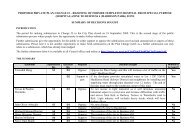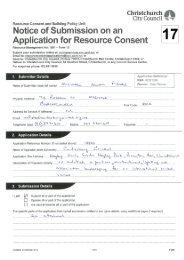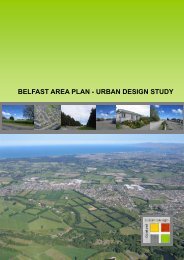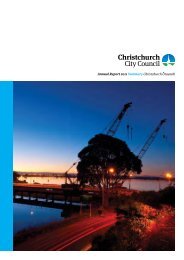Akaroa Historical Overview - Christchurch City Council
Akaroa Historical Overview - Christchurch City Council
Akaroa Historical Overview - Christchurch City Council
You also want an ePaper? Increase the reach of your titles
YUMPU automatically turns print PDFs into web optimized ePapers that Google loves.
The town becomes aware of its history<br />
<strong>Akaroa</strong> had been recognised since at least 1898 (when the monument was built on<br />
Green’s Point) to have a particularly interesting history. This had been reinforced by the<br />
1926 celebration of the 50 th anniversary of the establishment of the <strong>Akaroa</strong> Borough and<br />
by the 1940 celebration of the centennial of the signing of the Treaty of Waitangi and the<br />
founding of the first organised European settlements in New Zealand, of which <strong>Akaroa</strong><br />
was one. 31<br />
The town’s acknowledgement of its special past was given tangible expression with the<br />
founding of the <strong>Akaroa</strong> Museum. On the initiative of W.J. Gardner, a member of the<br />
Board of the Historic Places Trust, the Langlois-Eteveneaux Cottage was purchased in<br />
1961 and eventually vested in the County <strong>Council</strong>. The museum opened in 1964, with the<br />
cottage transformed into, in effect, a large display case. A new museum building was<br />
erected behind the cottage in 1967. Ten years later the museum was further extended. 32<br />
The extension designed by Colin Pilbrow, which provides the main entrance between the<br />
Langlois-Eteveneaux Cottage and the court house, is considered by many to be a model<br />
of new design sympathetic to historic neighbours.<br />
Two important historic buildings were added to the Museum. In December 1976, the<br />
restored customs house, near the base of Daly’s Wharf, was re-opened as part of the<br />
Museum. From the 1920s it had been used as a gardener’s shed before being given, in<br />
1970, by the County <strong>Council</strong> to the Museum Trust Board. 33<br />
After the court house (on a site adjacent to the Museum) closed in 1979, it was used, in<br />
1980-81, by the Lands and Survey Department for a photographic display of the<br />
Peninsula, but it was not until 1990 that it became part of the Museum. 34<br />
A place of special character<br />
Closely associated with an increasingly widespread perception that <strong>Akaroa</strong> was a place of<br />
special historic interest was the perception that it was also a place of special character,<br />
with old buildings and other historic remnants contributing significantly to that character<br />
but not the only reason <strong>Akaroa</strong> was special. By the early 21 st century it was commonly<br />
held that the town’s character derived from its unique topographical setting and gardens<br />
and trees as much as from a history that blended Maori, French and English strands and a<br />
remarkably well-preserved built environment. (The town’s setting, gardens and trees in<br />
the second half of the 20 th century are discussed in the following section.) 35<br />
Direct consequences of this growing perception that <strong>Akaroa</strong> had a special, distinctive<br />
character were the founding of the <strong>Akaroa</strong> Civic Trust in 1969-70 and the drafting of an<br />
“environmental plan” for the town. Both these developments had a profound effect on<br />
the development of <strong>Akaroa</strong> in the following four decades.<br />
A booklet put out later in the 1970s stated: “The character of <strong>Akaroa</strong> is at once unique<br />
and fragile. Conscious of this, residents and visitors have formed the <strong>Akaroa</strong> Trust [sic] to<br />
31 New Zealand Centennial News, 1938-41, passim<br />
32 Ogilvie, Cradle, p. 48<br />
33 The Press, 7 December 1976<br />
34 The Press, 1 December 1980, 9 January 1981, 22 July 1989; <strong>Akaroa</strong> Museum notice board<br />
35 <strong>Akaroa</strong> Civic Trust Newsletter, May 2006, pp. 3-5<br />
AKAROA HERITAGE OVERVIEW : SECTION 7 CHANGE AND GROWTH 1950 TO 2009 PAGE 136


